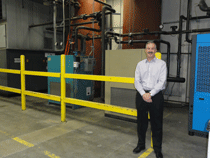Management and staff at plastics extrusion processor Intek are bearing down on energy use at their two facilities as part of a four-year program to reduce power consumption by 25%, or 1.5 million kilowatt hours (kWh). But after the success achieved in just the first year, they may have to raise the bar even higher.
January 6, 2011
Management and staff at plastics extrusion processor Intek are bearing down on energy use at their two facilities as part of a four-year program to reduce power consumption by 25%, or 1.5 million kilowatt hours (kWh). But after the success achieved in just the first year, they may have to raise the bar even higher.
Saving energy remains a topic high on many processors' "To do" lists. At Intek, a privately held company that extrudes and fabricates custom plastic extrusions for medium-to-large OEMs in a wide variety of end-use markets, company management devised a four-year plan for the period 2010-2014 to slash the processor's annual energy use by 25% by the end of the period. Intek operates two facilities, one each in Hastings, MN and Hawthorne, NJ. The processor was one of MPW's Notable Processors in 2007.
|
Mike Kinning, president of Intek, can smile now that the costs of the company's compressed air system (background) have been greatly reduced. |
Helping guide Intek's efforts is its Joint Energy Efficiency Plan (JEEP), with the four-year plan developed in cooperation with Xcel Energy, an electricity and natural gas power supplier in the U.S. Midwest and Northwest. The partnership give Intek access to special rebates for its energy-saving measures without it needing pre-approval from Xcel for each separate initiative. This helps Intek fund any capital investments that may be necessary without it needing special permission from Xcel for each separate initiative, even as the processor also saves money on its electrical use.
Turns out Intek's first JEEP year proved a good one, as the company was able to reduce its energy consumption by 17% in the first year-a decrease of more than 1 million kWh equivalent to about two-thirds of its overall goal.
How did they do it? "We've very intentionally and aggressively modified processes and equipment to substantially reduce our energy use," said Mike Kinning, president of Intek. "Our energy steering committee has done a phenomenal job identifying the areas and equipment where the biggest reductions were possible and tackled those projects first. We're seeing big payoffs already."
Intek's 125,000-ft2 manufacturing facility in Hastings houses over 20 extrusion lines and is the workplace of almost 200 employees. In late 2008, Intek consolidated its two Hastings facilities into the single current location. With all of the production in one facility, Intek management saw the need to reduce the company's electrical consumption to create greater capacity to accommodate the projected growth of the company.
Working with Xcel Energy, the company developed an energy reduction plan and formalized its commitment to reduce energy use and costs by signing the JEEP agreement with Xcel in December 2009. The JEEP project summary includes energy efficient upgrades to the company's compressed air system, lighting, manufacturing equipment, and heating/ventilation/air-conditioning (HVAC) systems, providing estimated energy savings and completion dates for each.
"We've made significant progress on the projects detailed in the JEEP summary," said Pete Barboni, continuous improvement manager and chairperson of the company's energy steering committee. "Some of the projects were relatively easy to implement, others have required sizeable investments of time and financial resources. Our senior management, the steering committee and other dedicated associates have made this initiative a top priority."
Compressed air high on the list
Intek's energy consumption is monitored quarterly to determine the effectiveness of each implemented measure at reducing total kilowatt-hours. Based on the estimated energy savings identified in the JEEP summary, the company has reduced its energy by more than 1 million kWh since December 2009. (Want tips on how to save on your compressed air use? Check our or article here on the topic.)
Most of the first year's initiatives focused on improving the efficiency of the facility's compressed air system. After indentifying and eliminating air leaks, modifications were made to processing equipment as well as reconfiguring existing air compressors to be able to reduce air pressure from 100 psi to 80 psi. As a result, the company has saved an estimated 628,430 kWh.
Further changes in manufacturing equipment and processes included the following: upgrading to more efficient vacuum pumps, improving the chilled water controls and shutdown process, reconfiguring the cleaning oven cooling system, and switching to more efficient air nozzles and rings. These changes resulted in a reduction of nearly 180,000 kWh.
HVAC modifications, such as installing additional air intake and exhaust fans, removing existing rooftop air conditioning units, and eliminating localized space heaters have netted the company a reduction of approximately 189,000 kWh.
In the company's offices, occupancy lighting sensors were added, employees paid closer attention to adjusting thermostats and inefficient vending machines were replaced, with these and other miscellaneous projects generating additional savings of 17,200 kWh.
Sustainable efforts also focus on scrap reduction
Late in 2009 the company introduced a scrap reduction program to improve material utilization and promote reclaiming and recycling of materials. Since the program was implemented, the company reports a 24% drop in material scrap and 30% decrease in waste sent to the landfill. The program rewards employees' support and contributions by sharing 50% of the savings. In 2010, Intek's employees each received more than $1000 worth of scrap-reduction incentives.
Intek actively promotes the use of recycled material in applications where virgin material may not be required. The company recycled nearly one million pounds of plastic internally in 2010 and purchased an additional one million pounds of recycled material from outside sources. Roughly 15-20% of the total pounds Intek extruded was from recycled material. —Matt Defosse
About the Author(s)
You May Also Like



